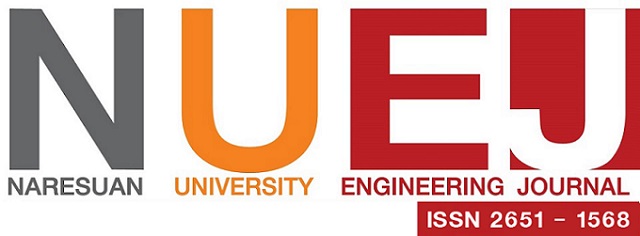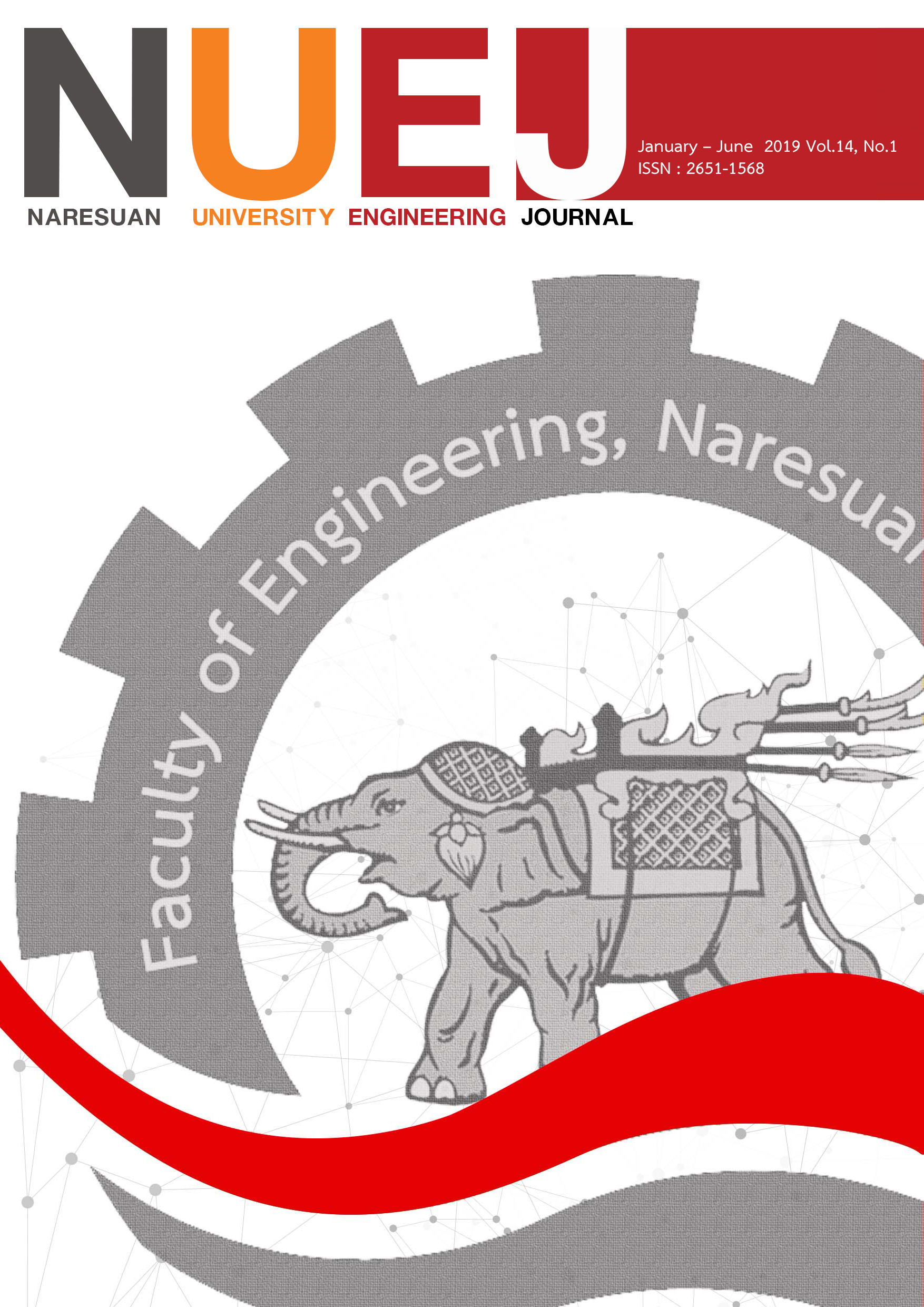การศึกษาความเป็นไปได้ทางเทคนิคของการใช้เถ้าหนักจากเตาเผาอุตสาหกรรมสำหรับผลิตเซรามิกประเภทดินเหนียว
Main Article Content
บทคัดย่อ
งานวิจัยนี้ศึกษาการใช้เถ้าหนักทดแทนดินเหนียวในการผลิตเซรามิกประเภทดินเหนียว ดินเหนียวที่ใช้ในการทดลองได้จากจังหวัดมหาสารคามและเถ้าหนักได้จากโรงงานอุตสาหกรรมในจังหวัดขอนแก่น โดยอบวัตถุดิบที่ 103 องศาเซลเซียสเป็นเวลา 24 ชั่วโมง บดและร่อนผ่านตะแกรงให้ได้อนุภาคเล็กกว่า 300 ไมครอน ทดสอบอัตราส่วนเถ้าหนักแทนที่ดินเหนียว ได้แก่ ร้อยละ 0, 20 และ 40 โดยน้ำหนัก เติมน้ำในส่วนผสมให้ได้ความชื้นร้อยละ 23-26 หล่อตัวอย่างในแบบอะคริลิกขนาด 30x60x10 ลูกบาศก์มิลลิเมตร บ่มที่อุณหภูมิห้อง 24 ชั่วโมง ทดสอบอุณหภูมิเผาที่ 400, 700 และ 1,000 องศาเซลเซียส และอัตราการเพิ่มอุณหภูมิ 1.5, 3 และ 9 องศาเซลเซียสต่อนาที เมื่อถึงอุณหภูมิที่กำหนดแล้วเผาต่ออีก 0 และ 4 ชั่วโมง จากนั้นทดสอบสมบัติทางกายภาพและทางกลเซรามิก สัณฐานวิทยาของอนุภาค และการชะของโลหะหนัก ผลการทดสอบพบว่า อัตราการเพิ่มอุณหภูมิเผา 3 และ 9 องศาเซลเซียสต่อนาทีทำให้เซรามิกเกิดการแตกร้าว ส่วนการเพิ่มอัตราส่วนเถ้าหนักแทนที่ดินเหนียวสามารถช่วยลดการหดตัวเชิงเส้นของเซรามิกลงได้ ในขณะที่กำลังรับแรงอัดและการดูดซึมน้ำของเซรามิกมีความสัมพันธ์แบบผกผันเชิงเส้นอย่างมีนัยสำคัญที่ระดับความเชื่อมั่นร้อยละ 99 โดยชิ้นงานที่ผสมเถ้าหนักร้อยละ 20 ให้ความร้อนด้วยอัตรา 1.5 องศาเซลเซียสต่อนาทีจนถึงอุณหภูมิ 1,000 องศาเซลเซียส และไม่ยืดเวลาเผาต่อ พบว่ามีการหดตัวเชิงเส้นร้อยละ 3.1 การดูดซึมน้ำร้อยละ 11.6 และให้กำลังรับแรงอัดสูงที่สุด 47.5 เมกะพาสคาล ซึ่งสอดคล้องกับผลของดิฟแฟรกโตแกรมที่พบคริสโตบาไลต์ซึ่งเป็นเฟสของแก้วที่สร้างความแข็งแรงให้โครงสร้าง แต่จะไม่พบที่อุณหภูมิเผาต่ำกว่า 1,000 องศาเซลเซียส เมื่อพิจารณาพลังงานที่ใช้ต่ำสุดในการเผาพบว่า ชิ้นงานที่ผสมเถ้าหนักร้อยละ 20 เผาที่ 700 องศาเซลเซียสเหมาะสมในการผลิตอิฐก่อสร้างที่ได้ตามมาตรฐาน ส่วนการชะของโลหะหนักจากเซรามิกผสมเถ้าหนักพบปริมาณ สารหนู ตะกั่ว ปรอท และซีลีเนียม ไม่เกินเกณฑ์มาตรฐานขององค์กรสิ่งแวดล้อมสหรัฐอเมริกา และมาตรฐานน้ำชะออกจากหลุมฝังกลบขยะอันตรายของสำนักบริหารจัดการกากอุตสาหกรรมประเทศไทย
Article Details
เอกสารอ้างอิง
[2] Electricity Generating Authority of Thailand. (1996). Research report on potential utilization of lignite fly ash (in Thai).
[3] Kositchaiyong, A., Mitrprasertporn, S., Wimolmala, E., Markpin, T. & Sombatsompop, N. (2010). Utilization of fly ash particles as cost reducing agent for rotational-moulded polyethylene product through blending condition improvement. Research and Innovation for Thai Industries Journal, 1, 43-53.
[4] Thongsang, S. & Sombatsompop, N. (2007). Reinforcement of natural rubber with fly ash from different local sources. Suranaree Journal Science and Technology, 14, 77-89.
[5] Vorakhan, V., Sombatsompop, N., Vimolmala, A. & Thongsang, S. (2010). Reinforcement of natural rubber with fly ash silica/precipitated silica hybrid filler. Science & Technology Journal, Ubon Ratchathani Universirt, 12, 9-20.
[6] McCarthy, M.J. & Dhir, R.K. (2005). Development of high volume fly ash cements for use in concrete construction. Fuel Journal, 84, 1423-1432.
[7] Kongsuk, M., Himalayan S., Thongarunsri S. & Tangprasirikul S. (2016). Effect of fly ash, limestone powder and bottom ash on shrinkage cracking behavior of concrete. Thailand Concrete Association Journal, 4, 30-39.
[8] Termkhajornkit, P., Nawa, T., Nakai, M. & Saito, T. (2005). Effect of fly ash on autogenous shrinkage. Cement and Concrete Research Journal, 35, 473-482.
[9] Jenjirapanya, S. & Krammart, P. (2016). A study on properties of cementitious material using industrial waste. Industrial Technology Journal, 12, 77-86.
[10] Editorial department. (2003). Research on utilization of fly ash. Engineering Today Journal, 2, Retrieved January 5, 2019, from http://www.technologymedia.co.th/articledetail.asp?arid=521&pid=75
[11] Bai, Y. Darcy, F. & Basheer, P.A.M. (2005). Strength and drying shrinkage properties of concrete containing furnace bottom ash as fine aggregate. Construction and Building Materials Journal, 19, 691-697.
[12] Huan-Lin, L., Shih-Huang, C., Deng-Fong, L. & Xin-Rong, C. (2017). Use of incinerator bottom ash in open-graded asphalt concrete. Construction and Building Materials Journal, 149, 497-506
[13] Naganathan, S., Yousef Omer Mohamed, A. & Nasharuddin Mustapha, K. (2015). Performance of bricks made using fly ash and bottom ash. Construction and Building Materials Journal, 96, 576-580.
[14] Rukzon, S., Phoopa, W., Ngernprom, N. & Chindaprasirt, P. (2014). The innovation of use of bottom ash on green concrete, Rajamagala University of technology Pra Nakorn Bangkok.
[15] Jiemsirilert, S., Jinawat, S., Kachima, P.D., Tripol, N., Wasanapianpong, T., Sujitworakul, P., et al. (2011). Development of low temperature coatings for earthenware and stoneware using silica. Ceramics Journal, 36, 53-55.
[16] Eli-Quesada, D. & Leite-Costa, J. (2016). Use of bottom ash from olive pomace combustion in the production of eco-friendly fired clay bricks. Waste Management Journal, 48, 323-333.
[17] Thai Industrial Standards Institute. (2018). Ceramic tiles. ISO 10545.
[18] ASTM C67-17. (2017). Standard test methods for sampling and testing brick and structural clay tile, ASTM International, West Conshohocken, PA, USA.
[19] U.S. Environmental Protection Agency. (1992). Method 13–11 toxicity characteristics leaching procedure (TCLP). Federal Register, Washington, DC, 51, 11798–11877.
[20] Pujari, A.S., Bhosale, C.H., Wagh, M.M. & Shinde, N.N. (2016). Effect of temperature on drying rate of various types of bricks. Engineering and Technology Journal, 3, 2793-2795. Retrieved April 5, 2019, from https://www.irjet.net/archives/V3/i5/IRJET-V3I5588.pdf
[21] Janduala, S. & Wasanapiarnpong, T. (2017). The development of lightweight clay brick with added bagasse ash. Sdu Research Journal, 1, 13-30.
[22] Bennour, A., Mahmoudi, S., Srasra, E., Boussen, S. & Htira, N. (2015). Composition, firing behavior and ceramic properties of the Sejnène clays. Applied Clay Science Journal, 115, 30-38. Retrieved April 5, 2019, from: https://doi.org/10.1016/j.clay.2015.07.025
[23] Hutchinson, C. & Yvonne. (1996). Ceramic technology for potters and sculptors. University of Pennsylvania. pp. 93–95. ISBN 9780812213775.
[24] Marras, SI., Ihtiaris, IA., Hatzitrifon, NK., Sikalidis, K. & Aifantis, EC. (2000). A preliminary study of stress-assisted fluid penetration in ceramic bricks. The European Ceramic Society Journal, 20, 489-495.
[25] Thai Industrial Standards Institute. (2002). Building bricks. TISI 77-2002.
[26] Biró, A., Hlavička, V. & Lublóy, E. (2019). Effect of fire-related temperatures on natural stones. Construction and Building Materials Journal, 10, 92-101. Retrieved April 5, 2019, from: https://doi.org/10.1016/j.conbuildmat.2019.03.333
[27] National Center for Biotechnology Information. (2006). Chemical entities of biological interest. Retrieved January 5, 2019, from https://pubchem.ncbi.nlm.nih.gov/compound/7009650#section=Top
[28] Soadsing, T. (1999). A studt of heavy metals in bottom ash from medical waste incinerators in phuket. Master. Science Technology of Environmental Planning for Rural Development, Mahidol University.
[29]Department of industrial promotion. (2005). Secure landfilling for industrial hazardous waste. Retrieved January 5, 2019, from http://www2.diw.go.th/iwmb/paper.asp


